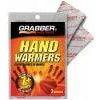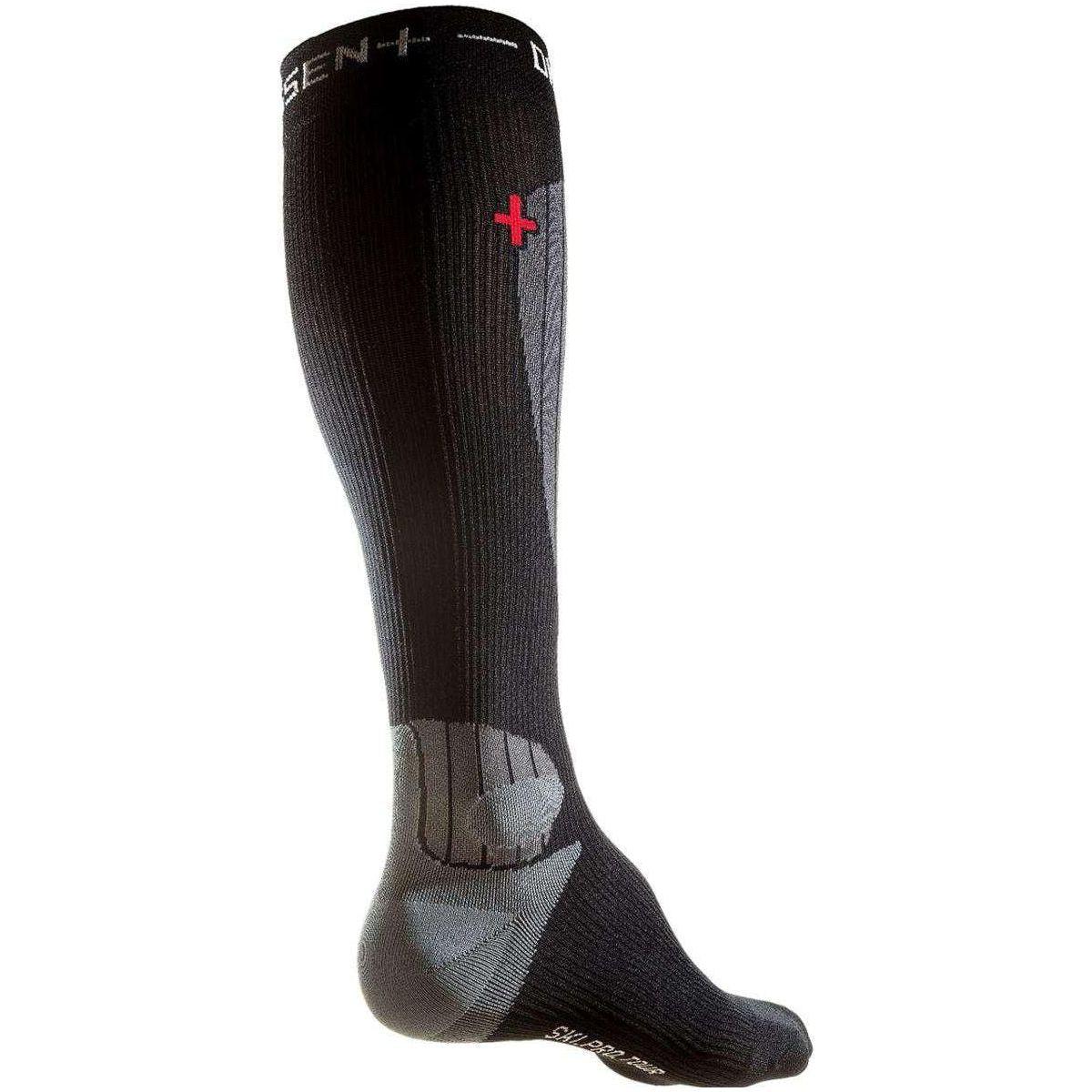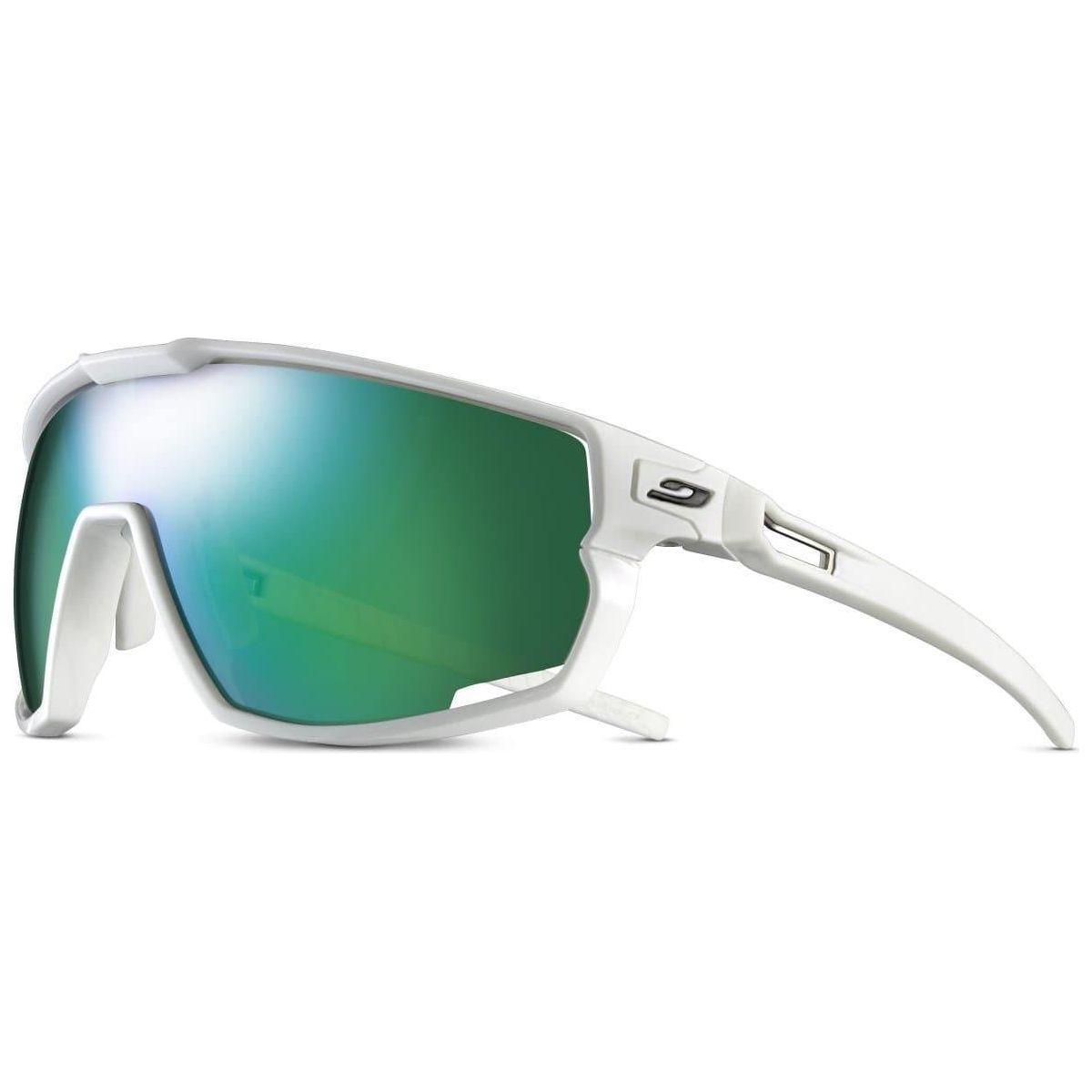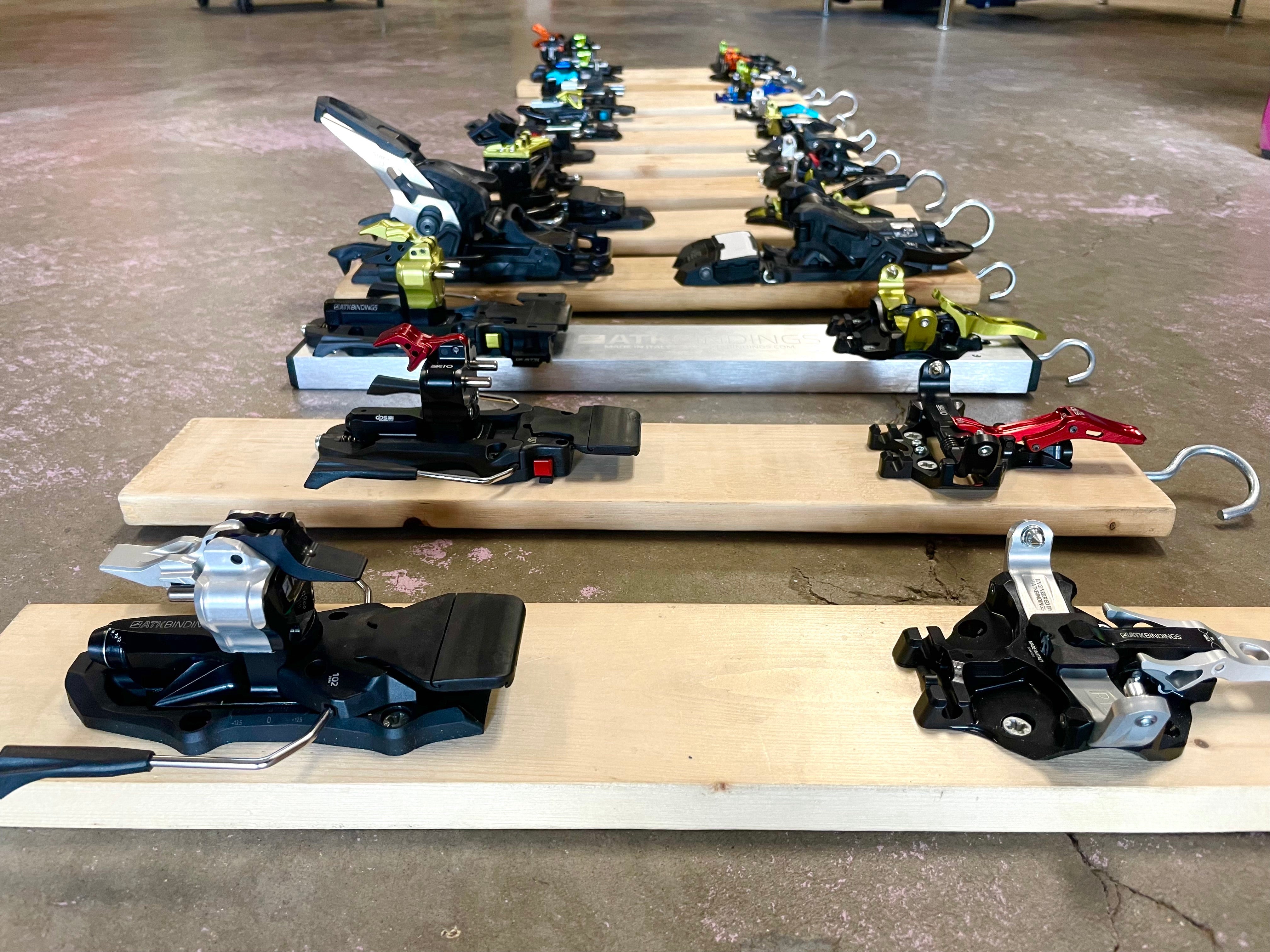With backcountry skiing going mainstream in the last decade, the number of binding options has exploded. Gone are the days when Dynafit tech bindings had a stranglehold on the market. Nearly every ski brand has poured massive R&D dollars into developing fantastic backcountry bindings, and binding technology has never been better. The only downside to this, for the consumer, is that there are so many options to choose from. If you want a deeper dive into ski touring and backcountry bindings, check out our blog post: How to Choose an Alpine Touring Binding.
For the 24/25 season, we've sorted through the mass of bindings and pulled our top picks in each category: freeride, all mountain, speed touring/mountaineering, and skimo race, respectively. For our selections, we consider weight, durability, and performance. While this list is not definitive, the bindings we've selected are what we ski year after year and the ones our customers consistently love. There are many options, so don't hesitate to reach out or book an appointment with us if you have questions or need help.
Freeride Touring Bindings
We've subdivided the quiver slot into hybrid bindings and backcountry freeride for the freeride category. Hybrid freeride bindings are suitable for resort skiing with the option to tour. They are the most robust and feature-heavy options on the market and often boast a DIN certification. For folks looking to do most of their skiing in bounds or those looking for a binding that puts a premium on downhill skiing above all else, this is the category for you.
Backcountry freeride bindings, on the other hand, are still designed primarily for out-of-bounds use. In this category, weight and uphill performance are still important, but these bindings are built to charge any line you might find, and they aren't afraid of getting air and variable conditions.
Hybrid Freeride
Salomon/Atomic Shift 2
When the Shift was released in 2018, it was one of the most anticipated and hyped touring bindings because of its innovative design and partly because it represented the big boys of the skiing industry pouring significant R&D into the backcountry world. For the 2024/25 season, the shift has undergone a facelift and is creatively called the Shift 2 (also referred to as the Shift^2). While the Shift 2 looks similar to the original, the manufacturers have worked hard to address user feedback and make a binding that still performs and feels like a Shift but with many of the annoyances of the old binding removed. The Shift 2 is produced by the ski conglomerate AMER Sports and is available in a Salomon, Atomic, and Armada branded package.
The updated Shift 2 has a redesigned AFD (anti-friction device). Like the previous iteration, the binding has an MNC certification, allowing adjustment to Alpine, Touring, WTR, and GripWalk sole norms. However, the old AFD was hard to adjust and often slipped down, causing play in the toe. The new “Micro AFD” addresses this issue and adds precise adjustments to your binding (ski techs everywhere rejoice!). The Shift 2 also features an updated brake. The old brake often deployed in touring mode, causing the brakes to drag when touring.
Additionally, the new brake mechanism adds 4 mm of riser height for climbing (the old binding's lack of a good climbing riser was another common complaint). The redesign of the toe is primarily focused on durability. The Shift 2 has wider toe wings and a reinforced toe lever. For those familiar with the old Shift, these were the two most common failure points, so it's great to see them addressed. AMER also claims this adds 30% more lateral stiffness to the binding.
The Shift 2 is perfect for people spending most of their time skiing in a resort, with the occasional foray into the backcountry or side country. It features a fully DIN-certified toe and heel release and plenty of elasticity to reduce prereleases. This translates into a binding that skis essentially like a standard alpine binding with plenty of power transfer and confidence. However, with a lever flick, the toe transforms into a pin binding for uphilling.
- Weight: 920 grams
- Release: 6-13
- MSRP: $549.99
What we like
The shift has excellent power transfer, and the DIN-certified release boosts confidence when charging hard and hitting big lines. Few bindings can compete with the shift for big freeride lines. Many of our complaints about the old shift (i.e., durability and bad touring functionality) have been addressed in the new Shift 2, and we are excited to see new life breathed into this classic binding. Specifically, the increased lateral stiffness and wider toe wings translate to a binding that is even more capable of driving a big ski at speed.
What we don’t like
At 920 grams, the Shift 2 is HEAVY. It matters less if you use it primarily for resort days with some skinning sprinkled in, but if you plan on more extended backcountry missions, your legs might be hurting. It's also complicated to use, with many moving parts and several steps to transition. This results in us seeing a fair number of broken Shifts and warranties, so buyers be warned: take your time to operate this binding correctly. The brake release mechanism is also tricky to operate with gloves during transitions. Even though they added 4mm of riser height, the shift still has only one riser compared to two in many of its competitors.

Cast Touring System Freetour 2.0 Pivot 15
The Cast Touring System converts a Pivot 15 or 18 into a touring binding. The Look Pivot has a legendary freeride pedigree and is beloved by skiers worldwide. The Cast adds heel risers and a brake locking mechanism to the heel and allows you to swap the toe out for a tech toe when ascending. With this system, you get the fantastic feel and durability of a Pivot in a touring package. The updated 2.0 version fixes many of the minor complaints of the old system. Notably, a better brake locking mechanism to keep the brakes from slipping down when touring and a new interface for changing the toes out. Switching toes on the old Cast was challenging, and the mechanism was prone to icing up. The Cast 2.0 is an excellent option for folks looking for a freeride setup they may occasionally tour with, a sled skiing setup, or if you can't be bothered by weight and want to huck cliffs and build backcountry booters.
- Weight: 1008g (uphill) 1343g (downhill)
- Release: 6-15
- MSRP: $779.95
What we like
The heart of the Cast is the Look Pivot, and we love that this system allows you to tour on one of the best alpine freeride bindings on the market. The updated design addresses many of our complaints—specifically, the mechanism for changing the toes out is miles above the old design. We also love that you can buy this as a complete kit, including a Look Pivot 15, or as a retrograde kit and repurpose an old set of Pivots (only compatible with Pivot 15 and 18).
What we don’t like
The Cast is an extremely heavy option. Admittedly, not all of this weight is on your feet since the alpine toe is carried in the pack, but with a total weight of 1343 grams (1008 grams on your feet in uphill mode), this thing is a beast. Transitions with the Cast are complex, especially in backcountry conditions with gloves. You also need to carry multiple parts, and if you forget or drop a toepiece, your day will be ruined.

Backcountry Freeride
ATK Freeriader Evo 15
The ATK Freeriader Evo 15 represents the latest iteration of ATK’s freeride bindings. At the core of the Evo is the redesigned toe piece, which has the same great construction as the old Freeraider but has an adjustable release value in the toe as well as the heel. This allows for fine-tuning the binding to your weight and skiing style as well as providing increased confidence to bomb massive lines. Other updates include a redesigned freeride spacer that sits more forward on the binding to give increased power transfer and stability and a new brake mechanism that’s easier and quicker to operate. Before, you needed to push the brake down while also operating a button to lock the brake upright; now, by rotating the heel tower, the brake automatically locks.
The ATK Freeriaders bindings have always sat in a class of their own because no other binding is as light while maintaining uncompromising downhill performance. For this reason, we call the Freeriader a true “backcountry freeride binding.” At 390 grams, this binding is extremely light, and for this reason, we wouldn’t recommend taking it to the resort and straight-lining icy bumps, but for the conditions you’ll find in the backcountry, the Freeriader Evo is more than capable.
What we like
The Freeriader Evo is a beautifully machined piece of equipment and epitomizes form meeting function. The aerospace grade aluminium is extremely durable and will stand up to years of abuse. An elastic heel, cam release pins, and adjustable release toe all give the Evo highly reliable and safe releasabilty and with a release value up to 15, you can really crank these bindings down and pin it. The Freeride spacer gives increased edge control and response as well as working to eliminate pre-releases. All this is packed into a light enough package to keep your legs fresh and ready for the descent.
What we don’t like
One of our biggest qualms with the old Freeraider 14 was that the brake mechanism was finicky to operate and could ice up. The new Raider Evo has addressed these issues, but the cost of this is that the brake will only lock when the heel is turned all the way around. With the old Raider, you could flip the raisers over the pins and operate it in “race mode” so you could uphill without turning the heel tower allowing for easy transitions. At $739.95 the Freeraider’s heafty price tag is also prohibitive for some.
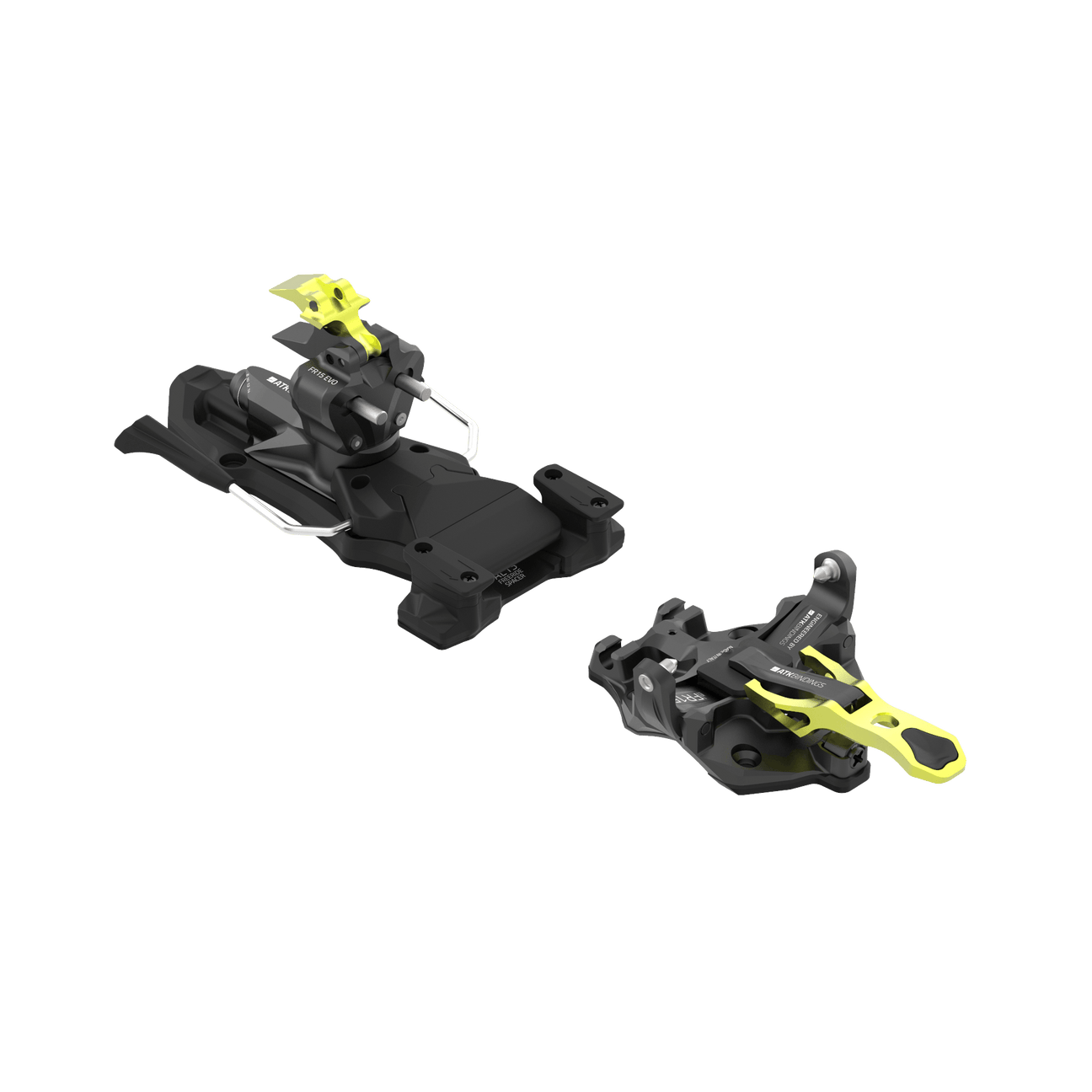
Dynafit ST Rotation
The Dynafit Rotation is Dynafit's most hard-charging, big ski-driving binding. It's also consistently our best-selling binding in this category. It's designed specifically with downhill performance in mind and is the perfect binding for someone looking to ski a tech binding hard or for the hesitant alpine skier who doesn't trust lighter tech binding options. The Dynafit ST Rotation is set apart by its toe piece, which features a swivel (hence the Rotation part of the name) that allows the whole toe piece to rotate. This function provides safer toe releases and adds elasticity to the toe, which helps eliminate pre-releases in the toe when laying down an edge. The ST Rotation also has a gapless heel, which means the heel tower touches your boot, and as the ski flexes, the tower moves with your boot to maintain contact. This further reduces pre-releasing and gives you the confidence to charge to your heart's content.
- Weight: 605 grams
- Release: 7-14
- MSRP: $599.95
What we like
The gapless heel, swivel toe, beefy construction, and high release value combine to make a binding that can charge just about any line in any condition. It's durable and well-built and will hold up to seasons of abuse. It also has the Dynafit Lifetime Guarantee, which provides a 10-year warranty on the binding. If you buy a Dynafit binding, you're guaranteeing yourself a working binding for the next ten years. At Cripple Creek, we deal with plenty of warranties and repairs, and the Dyanfit warranty and post-purchase support are some of the best in the industry. For us, this is a massive selling point for any Dyanfit binding.
What we don't like:
At 605 grams, the ST Rotation is significantly heavier than other options like an ATK. It can also be tricky to use. For one, some people report having problems stepping into it because the swivel function on the toe piece also means you must ensure your heel is lined up with the pins. We've also found that rotating the heel tower to unlock the brake and go into downhill mode takes a good amount of force. This isn't a huge issue, but is noticeably harder than many other bindings.

All mountain
ATK RT 11 Evo
It is not unfair to call the RT 11 Evo a paired-down version of the Freeraider Evo, as it boasts many of the same features but in a lighter package. However, that misses what the RT Evo 11 truly is: a quiver of one. I hate using this phrase, as it's thrown around too often, but honestly, no other binding will be as comfortable on powder skis to skinny mountaineering tools as the RT Evo. The RT heel is a Raider 11 Evo heel, so it has the “Cam Release” system, elastic travel, and the easy-to-use Evo brake system. The toe of the RT Evo is what sets it apart. With a minimalist design, the toe shaves weight while still offering an adjustable toe release and excellent anti-icing capabilities.
- Weight: 295 grams
- Release: 3-11
- MSRP: $639.95
What we like
At 295 grams per binding, this binding is featherweight for its feature-packed nature. The adjustable release in both the toe and heel gives you plenty of confidence as you fine-tune your release setting, and the easy-to-operate brakes and heel risers make moving quickly a breeze. ATK has allowed consumers to choose a Raider-like binding in a lighter package, making the RT Evo a perfect all-mountain binding that can push into the mountaineering or freeride category.
What we don't like
The $639.95 MSRP is hefty for an all-mountain binding. Often, folks getting into the sport choose an all-mountain quiver slot, so we wish this binding was more accessible. While ATK has cheaper bindings in this category, they lack many features we love about the RT 11 Evo. As with other Evo brake designs, you no longer have the functionality of using the binding in "race mode," you have to turn the heal tower to lock the brake. Along these lines, skiing this binding without a brake isn't a great option. In a 295g binding, we would love to save some extra weight by using a leash instead of a brake.

Dynafit Radical
The Radical has remained relatively unchanged for years, and this tried and true design makes it an excellent all-around binding. It is modular and easy to use, which means pieces can be easily replaced, and with the 10-year Dyanfit Lifetime Guarantee, this binding will keep kicking for years and years. With a fully adjustable lateral and horizontal release in the heel, three riser heights, and an excellent range of adjustment, this binding has a complete set of features. We will be honest: the Radical isn't flashy and is relatively simple. However, it makes this list because it's such a timeless design that we return to every year. Additionally, the Radical has undergone a significant price decrease this year and is now available for $399.95. This binding is also available in the Speed Radical format, a brakeless option that is lighter and easier to operate during transitions.
- Weight: 535 grams
- Release: 4-10
- MSRP: $399.95
What we like
The Radical is the tried and true daily driver of the touring world. It has seen it all and ready to keep going. We love that a superb warranty backs it, that it's easy to fix and service, and that its simple design works well and is reliable. It’s also budget-friendly and packs enough performance for most skiers.
What we don’t like
The Radical falls into the trap of being a "jack of all trades master of none." It sits so solidly in the middle of touring bindings that it doesn’t excel at any one thing. It's not the lightest, and it doesn't have the best downhill performance. For people looking for the latest and greatest, you may want to dish out the extra cash and get a little more high-tech. While the warranty is great, the plastic construction isn’t always the most durable, so heavier and more aggressive riders may need to seek the aluminum construction of brands like ATK.
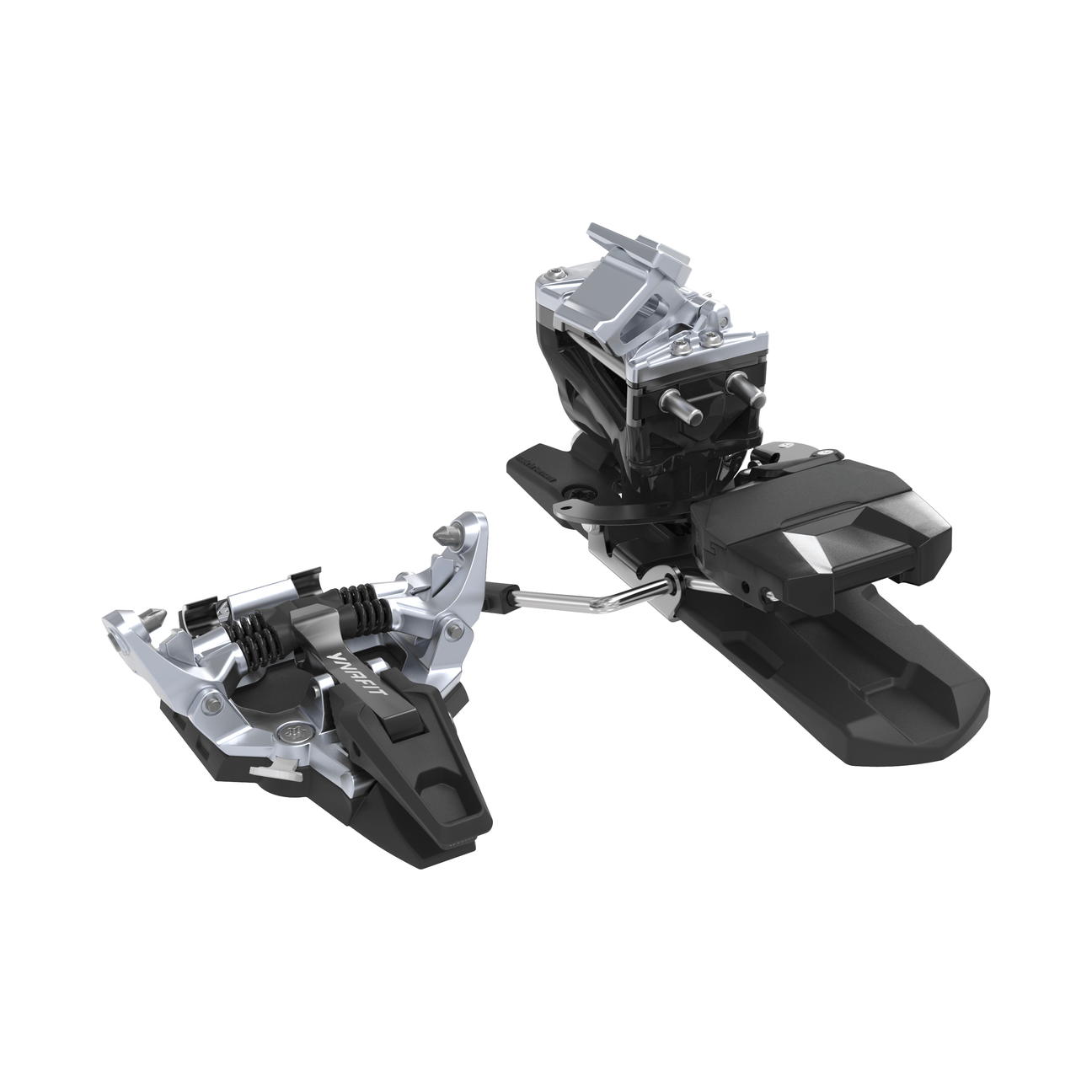
Speed Touring/ Ski Mountaineering
ATK Timepacer 12
What, another ATK, you ask? Well, we can't help it that ATK makes a damn good binding! New for the 24/25 season, the Timepacer 12 is a genre-bending binding that borrows heavily from the ATK skimo race line. Notably, the heel looks like a beefed-up version of the ATK World Cup and has the same brake mechanism where the riser is connected to the brake by a wire and pulley system. This allows the brake to be actuated by the riser and gives it a wicked-fast transition. The toepiece is also beefed up and optimized for easy step-in and anti-icing. Overall, the Timepacer is ideal for driving a wider ski with a race-style binding or for a fitness/training binding with more features, durability, and downhill performance than an actual race binding.
- Weight: 215 grams
- Release: 6-10
- MSRP: $549.95
What we like
The Timpacer 12 toepiece is beautiful, and we hope we see more bindings with similar toepieces. It's sleek and light, and the anti-icing features are excellent for something this lightweight. Similarly, the heel is minimalist and light, with the widest brake options for bindings in this weight category. The race-style brake/riser combo is perfect for folks looking for easy and fast transitions. We also love that the transition style is the same as the World Cup, which makes this superb for folks using it as a training binding alongside their ATK race setup.
What we don't like
The Timepacer 12 lacks a flat mode, and while this isn't a significant problem when used with the correct boot, it's a bonus feature we wish this had. The brake mechanism is more complicated than most, and while it's beefier than the variant found in race bindings, we still worry about the durability. Additionally, the brake/riser mechanism is primarily internal, so repair often requires a complete warranty/replacement of the heel.

Dynafit Superlite 150
The Superlite 150 is one of the most sought-after bindings among the gram-counting enthusiasts. Indeed, the Superlite is our favorite in the extensive list of Dynafit's binding offerings. As the name suggests, this minimalist piece of engineering tips the scales at 150 grams without a brake or adjustment track, which puts it in contention with some race bindings. The Superlite 150 is constructed almost entirely of 7075 forged aluminum and has a wide mounting pattern, allowing for a nice power transfer edge to edge. The 150 has an adjustable lateral release value and a fixed vertical value, but if you're a lighter skier, you can replace the stock U-spring with a softer spring (release value of 6).
- Weight: 150 grams
- Release: 4-13
- MSRP: $519.96
What we like
The Superlite 150 weighs as much as some race bindings but has greater durability and versatility, and this added versatility is what sets the Superlite 150 apart. Along these lines, the Superlite can be configured in several ways. For the gram shavers out there, you can hard mount them with no adjustment track, or if you want to accommodate several boots, you can add an adjustment track. There is also an option to toss on a brake. The full aluminum construction is durable and confidence-inspiring. If you want a binding that's as light as possible while still allowing for big backcountry missions, the Dynafit Superlite 150 is as good as it gets.
What we don’t like
The Superlite 150 is still an ultralight piece of equipment, which means that compared to heavier bindings, it is more fragile. Specifically, if it's abused, we've seen the toe excenter (the plastic piece used for locking and exiting the toe) brake. Luckily, the Dynafit 10-year warranty and easy access to parts means getting any repairs done is painless and usually free. The heel tower is designed not to have a flat mode; instead, you have two riser heights and a "race mode" where you can cover the pins and go uphill without turning the heel tower. This is fine for many, but some people find the lack of flat mode a bummer. If you are using the binding without a brake, you can glue a piece of cork to the ski and use the binding in a flat mode, but this is an aftermarket solution not sanctioned by Dynafit.
Race
ATK World Cup Revolution
The World Cup Revolution is the lightest, most race-optimized binding in the ATK lineup. ATK stripped the World Cup down to the bones, and a 120-gram weight results from minimalist design and the best materials on the market. With 7078 aluminum and titanium, don't let the light weight fool you: the World Cup Revolution is a durable tool designed for the highest level of skimo performance. The toe piece features ATK's springless toe, which reduces ice buildup and allows for three retention levels in the uphill locking mode. ATK has two other iterations of the World Cup: the Trofeo and the SL, which have slightly different toe-piece designs. There are also LT versions available for lighter skiers and versions with and without brakes to meet new ISMF regulations.
- Weight: 120 grams
- Release: 9 (fixed)
- MSRP: $669.95
What we like
As with all ATK bindings, attention to detail and the use of premium materials and construction methods are enormous bonuses. In this case, we love that a 120-gram binding features complete metal construction and can handle the abuse of the most demanding race courses. Combined with the unique toepiece that sets the World Cup Revolution apart, athletes will appreciate the easy step-in when transitioning from boot packing.
What we don't like:
The biggest issue with this binding is that the metal heel raiser that covers the heel pins may eventually fail. It's purely an issue of metal fatigue and occurs after heavy use. Luckily, this is easily replaceable, and the part only costs $20. The key takeaway is that you must inspect your lightweight gear to avoid failure. In this case, you're looking for metal discoloration and apparent signs of wear. You should only have issues once you've put the World Cup through the wringer, but since the rest of the binding will last season after season, you may eventually need to do the replacement.

Plum Race 150
Plum has been making the Race 150 for years, making it one of the most reliable lightweight bindings on the market. The Race 150 will outlast just about any other gear you have. As the name suggests, the Race 150 tips the scale at 150 grams, so it's not the lightest binding out there. However, compared to Plum's lighter race bindings, the 150 is set apart by its durability and consistency. Because of this, the Race 150 has also become a favorite among gram-shaving ski mountaineers, speed tourers and podium-chasing racers.
- Weight: 150 grams
- Release: 8 (fixed)
- MSRP: $439.99
What we like
This binding is a workhorse. It's not a speedy show pony, but you'll find yourself using it year after year and never worrying or doubting that it'll continue to perform. It's reasonably priced, and the durable construction makes it a versatile binding that allows you to do almost anything.
What we don't like
The Race 150 is about 50 grams heavier than the premium ultralight race bindings on the market; for most people, that's a negligible difference, but if you are trying to push the limits of what's possible, you may want to look at a lighter option. The Race 150 is also available with an adjustment track branded as the Race 170. While we appreciate the added versatility of the Race 170, the adjustment track is finicky and sometimes loosens, allowing the heel tower to move. The solution is to apply generous amounts of thread lock to the track screws and ensure they are properly torqued. With careful love, the Race 170 will work fine for anyone, but our pick is the Race 150 mounted with no adjustment track.


